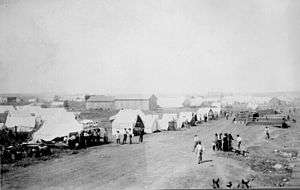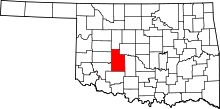Anadarko, Oklahoma
| Anadarko, Oklahoma | |
|---|---|
| City | |
|
Downtown Anadarko, Oklahoma | |
| Motto: "Indian Capital of the Nation" | |
|
Location of Anadarko, Oklahoma | |
| Coordinates: 35°4′9″N 98°14′46″W / 35.06917°N 98.24611°WCoordinates: 35°4′9″N 98°14′46″W / 35.06917°N 98.24611°W | |
| Country | United States |
| State | Oklahoma |
| County | Caddo |
| Area | |
| • Total | 7.2 sq mi (18.6 km2) |
| • Land | 7.1 sq mi (18.4 km2) |
| • Water | 0.1 sq mi (0.2 km2) |
| Elevation | 1,181 ft (360 m) |
| Population (2010)[1] | |
| • Total | 6,762 |
| • Density | 940/sq mi (360/km2) |
| Time zone | Central (CST) (UTC-6) |
| • Summer (DST) | CDT (UTC-5) |
| ZIP code | 73005 |
| Area code(s) | 405 |
| FIPS code | 40-02050[2] |
| GNIS feature ID | 1089618[3] |
| Website | City Website |
Anadarko is a city in Caddo County, Oklahoma, United States. This city is fifty miles southwest of Oklahoma City. The population was 6,762 at the 2010 census,[1] a 1.8 percent gain from 6,645 at the 2000 census. It is the county seat of Caddo County.[4]
History

Anadarko got its name when its post office was established in 1873. The designation came from the Nadarko Indians, a branch of the Caddo, and the "A" was added by clerical error.[5]
In 1871, the Wichita Agency was reestablished on the north bank of the Washita River after being destroyed in the American Civil War. The Wichita Agency administered the affairs of the Wichita, Caddo and other tribes. In 1878, the Kiowa-Comanche Agency at Fort Sill was consolidated with the Wichita Agency.[5]
In 1901, the federal government allotted the lands of the Kiowa, Comanche and Arapaho Reservations, and opened the surplus land to white settlement. On August 6, 1901, an auction was held for homesteads and town lots. Around 5,000 people were living in "Rag Town" on the east edge of Anadarko awaiting the auction. Although 20,000 people were present for auction day, Anadarko's population dwindled to 2,190 in 1907.[5]
Agriculture has been the principal driver of the local economy, since the Washita Valley has been good for crops and livestock. The second pillar of the local economy has been Indian affairs.[5]
Geography
Climate
| Climate data for Anadarko, Oklahoma | |||||||||||||
|---|---|---|---|---|---|---|---|---|---|---|---|---|---|
| Month | Jan | Feb | Mar | Apr | May | Jun | Jul | Aug | Sep | Oct | Nov | Dec | Year |
| Average high °F (°C) | 49 (9) |
55 (13) |
62 (17) |
71 (22) |
88 (31) |
88 (31) |
93 (34) |
93 (34) |
85 (29) |
74 (23) |
61 (16) |
50 (10) |
72.4 (22.4) |
| Average low °F (°C) | 23 (−5) |
28.7 (−1.8) |
35 (2) |
44 (7) |
56 (13) |
65 (18) |
70 (21) |
68 (20) |
59 (15) |
47 (8) |
35 (2) |
25 (−4) |
46.31 (7.93) |
| Average precipitation inches (mm) | 1.14 (29) |
1.67 (42.4) |
2.61 (66.3) |
2.77 (70.4) |
4.89 (124.2) |
4.52 (114.8) |
2.46 (62.5) |
2.81 (71.4) |
3.12 (79.2) |
3.68 (93.5) |
1.97 (50) |
1.67 (42.4) |
33.31 (846.1) |
| Source: Weatherbase.com [6] | |||||||||||||
Demographics
| Historical population | |||
|---|---|---|---|
| Census | Pop. | %± | |
| 1910 | 3,439 | — | |
| 1920 | 3,116 | −9.4% | |
| 1930 | 5,036 | 61.6% | |
| 1940 | 5,579 | 10.8% | |
| 1950 | 6,184 | 10.8% | |
| 1960 | 6,299 | 1.9% | |
| 1970 | 6,682 | 6.1% | |
| 1980 | 6,378 | −4.5% | |
| 1990 | 6,586 | 3.3% | |
| 2000 | 6,645 | 0.9% | |
| 2010 | 6,762 | 1.8% | |
| Est. 2015 | 6,717 | [7] | −0.7% |
As of the census of 2010, there were 6,762 people residing in the city.[1] The population density was 937 people per square mile (361.9/km²). There were 2,800 housing units at an average density of 390.2 per square mile (150.7/km²).[1] The racial makeup of the city was 41.37% White, 6.23% African American, 41.26% Native American, Asian, 0.03% Pacific Islander, 3.07% from other races, and 7.80% from two or more races. Hispanic or Latino of any race were 9.15% of the population.
There were 2,387 households out of which 36.3% had children under the age of 18 living with them, 43.6% were married couples living together, 20.2% had a female householder with no husband present, and 30.6% were non-families. 27.1% of all households were made up of individuals and 13.6% had someone living alone who was 65 years of age or older. The average household size was 2.72 and the average family size was 3.32.
In the city the population was spread out with 32.6% under the age of 18, 9.3% from 18 to 24, 25.8% from 25 to 44, 18.8% from 45 to 64, and 13.5% who were 65 years of age or older. The median age was 32 years. For every 100 females there were 87.9 males. For every 100 females age 18 and over, there were 81.3 males.
The median income for a household in the city was $24,035, and the median income for a family was $27,633. Males had a median income of $26,063 versus $17,666 for females. The per capita income for the city was $12,062. About 23.3% of families and 28.5% of the population were below the poverty line, including 38.8% of those under age 18 and 18.5% of those age 65 or over.
Culture
Anadarko is the home of the Native American drum group Cozad Singers.
Native American significance

Anadarko, self-titled, "Indian Capital of the Nation," is home to the annual American Indian Exposition. It is one of two places in Oklahoma where a Lenape tribe is headquartered, the other being Bartlesville. The city houses the National Hall of Fame for Famous American Indians.
Anadarko is named after the Nadaco, a Caddo band now affiliated with the Caddo Nation. In the Caddo language, Nadá-kuh, means "bumblebee place".[9] The Caddo are a federally recognized American Indian tribe for which Caddo County is named; Caddo County is part of the former reservation of the Caddo, Wichita, and Western Delaware, prior to allotment in the post-Dawes Allotment Era.
Culturally, Anadarko is rare among Oklahoma cities as Native Americans form a near-majority. Locals are often familiar with a few basic Indian words, such as haw-nay, Kiowa for "no." Wichita and Apache words are sometimes employed in casual conversation as well, such as hangy, ah-ho, ebote, and bocote. Indian motifs are commonly used for design, art, and other aspects of daily life.
Anadarko has a Bureau of Indian Affairs office. The town is situated between the Wichita, Caddo, and Delaware reservations to the north, and the Kiowa, Comanche, and Apache reservations to the south. These reservations, along with all but the Osage Reservation in northeastern Oklahoma, were dismantled by the allotment of tribal lands to individual members, and the opening of the "excess" lands to settlement, in a series of land openings. The area surrounded by Anadarko was opened to settlement by a 1901 land lottery affecting the Kiowa, Comanche, Wichita and Caddo lands.
Anadarko is home to Riverside Indian School, a Bureau of Indian Education boarding and day school for Native American students. Indian City USA cultural center, now owned by the Kiowa Tribe, is located 2–1/2 miles southeast of Anadarko. Indian City is now closed; it is yet to decide when it will re-open.
Education
Anadarko Public Schools consists of three elementary schools, Sunset Elementary, East Elementary, and Mission Elementary; a middle school; and a high school.[10] There are approximately 1,950 students.[11]
Notable people
- Richard Aitson (b. 1953), a Kiowa-Kiowa Apache bead artist, curator, and poet
- Black Beaver (1806—1880), Delaware Indian leader, scout, and rancher
- Blackbear Bosin (1921-1980), Comanche-Kiowa artist
- Derrell Griffith (b. 1943), former Major League Baseball player
- Ralph B. Hodges (1930-2013), former Chief Justice of the Oklahoma Supreme Court
- Genta H. Holmes (b. 1940), first United States Ambassador to Namibia
- Butch Huskey (b. 1971), former Major League Baseball player
- Charles Leonhard (1915-2002), Music educator and academic
- Hugh McCullough (1916-1999), National Football League player
- Doris McLemore (1927–2016) last fluent speaker of the Wichita language
- Cal McLish (1925-2010), Major League Baseball player
- Stephen Mopope (1900-1974), Kiowa artist
- Gary Nixon (1941-2011), national champion motorcycle racer
- Ray Gene Smith (1928–2005), American football player
- Jim Thompson (1906-1977), Author and screenwriter
- Gene Tracy (1927–1979), American comedian, emcee, and recording artist
- Louis Weller (1904-1979), National Football League player
References
- 1 2 3 4 "2010 City Population and Housing Occupancy Status". U.S. Census Bureau. Archived from the original on July 21, 2011. Retrieved October 18, 2013.
- ↑ "American FactFinder". United States Census Bureau. Archived from the original on 2013-09-11. Retrieved 2008-01-31.
- ↑ "US Board on Geographic Names". United States Geological Survey. 2007-10-25. Retrieved 2008-01-31.
- ↑ "Find a County". National Association of Counties. Archived from the original on 2011-05-31. Retrieved 2011-06-07.
- 1 2 3 4 Carolyn Riffel and Betty Bell, "Anadarko." Encyclopedia of Oklahoma History and Culture. Accessed April 17, 2015.
- ↑ "Historical Weather for Anadarko, Oklahoma, United States".
- ↑ "Annual Estimates of the Resident Population for Incorporated Places: April 1, 2010 to July 1, 2015". Retrieved July 2, 2016.
- ↑ "Census of Population and Housing". Census.gov. Archived from the original on May 11, 2015. Retrieved June 4, 2015.
- ↑ Sturtevant, William C., general editor and Raymond D. Fogelson, volume editor. Handbook of North American Indians: Southeast. Volume 14. Washington DC: Smithsonian Institution, 2004: 630. ISBN 0-16-072300-0.
- ↑ Anadarko Public Schools Archived October 13, 2011, at the Wayback Machine.. Retrieved 24 March 2013.
- ↑ "Anadarko Public Schools". Anadarko Public Schools. Archived from the original on 2011-10-13. Retrieved 2012-03-06.
External links
| Wikimedia Commons has media related to Anadarko, Oklahoma. |
- City of Anadarko
- Anadarko Chamber of Commerce
- Picture of a 1913 lynching that occurred in Anadarko
- Encyclopedia of Oklahoma History and Culture - Anadarko (Town)
- "Daily Democrat" newspaper hosted by the Gateway to Oklahoma History.
